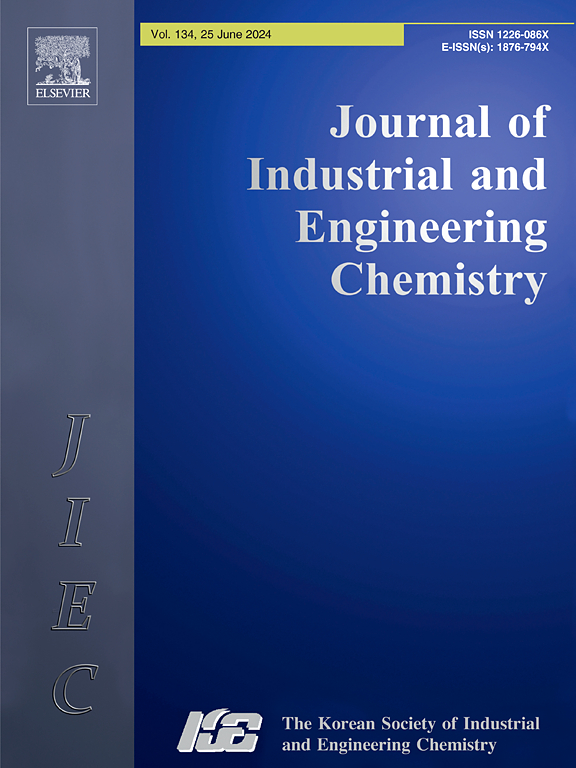钨磷酸在h-BN上光催化降解染料的建模和优化:RSM、ANN和ANFIS比较方法
IF 5.9
3区 工程技术
Q1 CHEMISTRY, MULTIDISCIPLINARY
Journal of Industrial and Engineering Chemistry
Pub Date : 2024-12-02
DOI:10.1016/j.jiec.2024.11.059
引用次数: 0
摘要
废水染料对水生环境构成重大威胁,造成水污染,危害人类健康和生态系统。本研究通过合成钨磷酸(TPA)和多孔六方氮化硼(h-BN)纳米复合材料(TPA@h-BN)解决了对染料有效降解技术的迫切需求。将TPA固定在不同量(10 - 40%)的h-BN纳米片上,30% TPA@h-BN复合材料在亚甲基蓝(MB)染料降解中表现出优异的光催化性能。采用中心复合设计(CCD)设计的批量实验对光催化过程进行了研究。随后,采用响应面法(RSM)、人工神经网络(ANN)和自适应神经模糊推理系统(ANFIS)对反应时间、催化剂用量、染料浓度和搅拌速度的影响进行了建模。计算3种模型的统计参数,得到RSM、ANN和ANFIS的回归系数R2分别为0.981、0.977和0.928。结果表明,相对于ANFIS模型,RSM和ANN模型具有更高的预测能力和精度。采用30% TPA@h-BN溶液60 mg, 15 ppm染料浓度,550 rpm搅拌,240 min可达到95.40%的最佳染料降解率。该过程符合准一级动力学,速率常数为0.01303 min−1。本文章由计算机程序翻译,如有差异,请以英文原文为准。

Modeling and optimization of photocatalytic dye degradation using tungstophosphoric acid on h-BN: RSM, ANN and ANFIS comparative approaches
Effluent dyes are a significant threat to aquatic environments, causing water pollution that endangers human health and ecosystems. This study addresses the urgent need for effective dye degradation technologies by synthesizing tungstophosphoric acid (TPA) and porous hexagonal boron nitride (h-BN) nanocomposites (TPA@h-BN). TPA was immobilized on h-BN nanosheets in varying amounts (10–40 %), with the 30 %TPA@h-BN composite showing superior photocatalytic performance in methylene blue (MB) dye degradation. The photocatalytic process was investigated using batch experiments designed by central composite design (CCD). Subsequently, response surface methodology (RSM), artificial neural network (ANN) and adaptive neuro-fuzzy inference system (ANFIS) were employed to model the effects of reaction time, catalyst dosage, dye concentration and stirring speed. Statistical parameters were calculated for all three models, with the regression coefficients (R2) for RSM, ANN and ANFIS found to be 0.981, 0.977 and 0.928, respectively. These results indicate that the RSM and ANN models possess higher predictive capability and accuracy compared to the ANFIS model. Optimal dye degradation of 95.40 % was achieved in 240 min using 60 mg of 30 %TPA@h-BN, 15 ppm dye concentration and 550 rpm stirring. The process followed pseudo-first-order kinetics with a rate constant of 0.01303 min−1.
求助全文
通过发布文献求助,成功后即可免费获取论文全文。
去求助
来源期刊
CiteScore
10.40
自引率
6.60%
发文量
639
审稿时长
29 days
期刊介绍:
Journal of Industrial and Engineering Chemistry is published monthly in English by the Korean Society of Industrial and Engineering Chemistry. JIEC brings together multidisciplinary interests in one journal and is to disseminate information on all aspects of research and development in industrial and engineering chemistry. Contributions in the form of research articles, short communications, notes and reviews are considered for publication. The editors welcome original contributions that have not been and are not to be published elsewhere. Instruction to authors and a manuscript submissions form are printed at the end of each issue. Bulk reprints of individual articles can be ordered. This publication is partially supported by Korea Research Foundation and the Korean Federation of Science and Technology Societies.

 求助内容:
求助内容: 应助结果提醒方式:
应助结果提醒方式:


